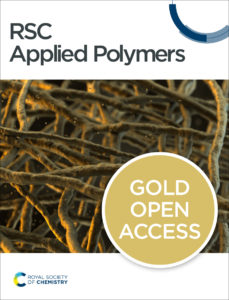To celebrate the growth and development of the RSC Applied Polymers community and to highlight the remarkable authors who continue to contribute their high quality work to the journal we would like to share the opinions and insights of these authors through this introductory blog post. Once dubbed #RSCAppliedfirst50, our blog posts aim to give a voice to the authors behind the research and hope that their insights might shed light upon growing challenges and progress in polymer science and its applications.
In this edition, we hear from Ramya Kumar in a short interview about their study entitled ‘Poly(L-glutamic acid) augments the transfection performance of lipophilic polycations by overcoming tradeoffs among cytotoxicity, pDNA delivery efficiency, and serum stability.’
Insight from the authors of ‘Poly(L-glutamic acid) augments the transfection performance of lipophilic polycations by overcoming tradeoffs among cytotoxicity, pDNA delivery efficiency, and serum stability.’
What aspect of your work are you most excited about at the moment?
In just the last four years, we have witnessed several breakthroughs in how cell- and gene-based therapeutics can save lives. These lifesaving treatments are currently restricted to a privileged cohort residing predominantly in wealthy Western countries. Synthetic materials, such as polymers, can broaden access to these treatments so that more people can afford to benefit from them. We are living in an exciting period where synthetic polymer chemistry, machine learning tools, and next-gen biologics are evolving in tandem. We have the unprecedented opportunity to leverage these advances to democratize access to these technologies. Even if the materials we study in the lab don’t end up succeeding in a clinical setting, the training we pass on to the next generation of scientists is invaluable in solving similar problems in related research domains.
In your opinion, what are the most important questions to be asked/answered in your field of research?
- Are polymer design rules conserved across diverse genome editor payloads? Protein engineers are innovating more powerful and sophisticated genome editor proteins at a rapid pace. It’s important that polymers keep up with this rapidly evolving landscape. We don’t yet know if the same polymer will be universally efficacious in delivering all genome editors.
- What are the molecular design principles driving cell-type-preferential nucleic acid delivery? Polymers must deliver nucleic acids to target cells while avoiding off-target cells. Unlike lipid nanoparticles, where ligand-free nanocarriers are being engineered through rational protein corona design, molecular principles governing polymer-mediated gene delivery across cell types remain elusive.
- How can we design polymeric cell culture substrates that help us model important cellular transformations such as stem cell self-renewal and macrophage activation?Current experimental models for interrogating these cellular processes are limited in the questions they can ask and often fail to draw robust conclusions. Cell culture substrates functionalized with bioinstructive polymer coatings can catalyze cellular transformations and answer fundamental cell biology questions.
What do you find most challenging about your research?
In both of my research thrusts (bioinstructive polymer coatings and polymers for nucleic acid delivery), subtle alterations to polymer composition and molecular design can have dramatic effects on their biological performance. Some of these experimental outcomes cannot be predicted using current heuristics and structure-function relationships. Explaining why some polymers perform well in a given biomaterial application while others falter has always been challenging. Developing tools (e.g., high-throughput proteomics, machine learning models) to better understand and predict these counterintuitive results is going to take time, but I am excited about the potential of these predictive tools.
In which upcoming conferences or events may our readers meet you?
I just attended ACS Denver and will be co-organizing the Society for Biomaterials Western Conference in Denver this September.
Where do you see your own research going in the future?
Currently, my lab applies polymer synthesis, biointerfacial characterization, and machine learning to lower economic, manufacturing, and logistical barriers confronted by cellular and macromolecular therapeutics. I always hope to work at the interface of polymers and biology. In the long term, it would be exciting to apply personalized and precision medicine approaches to polymeric biomaterial design so that we can create bespoke polymers that adapt to individual patients’ immune systems. It would also be interesting to integrate polymer chemistry tools with multi-omics datasets to engineer patient-specific nanocarriers.
Polycations are promising nanocarriers for delivering therapeutic nucleic acids due to their scalability and affordability, but efficient polycationic vehicles often exhibit high cytotoxicity and poor serum stability, hindering clinical translation. The study investigates the use of poly(L-glutamic acid) (PGA) as a surface modifier to improve the performance of lipophilic polycations in plasmid DNA (pDNA) delivery, aiming to resolve the trade-offs between nucleic acid delivery efficiency, cytotoxicity, and serum stability. The sequence of addition of polycations, pDNA, and PGA is critical, with PGA needing to be added last to avoid disrupting polycation-mediated pDNA condensation. Techniques like circular dichroism spectroscopy, PicoGreen dye exclusion assays, and confocal microscopy were used to analyze polyplex properties and performance. Key findings include that PGA significantly reduces the cytotoxicity of lipophilic polycations, tripling the population of transfected viable cells, and improves serum tolerance, preventing aggregation and maintaining pDNA delivery efficiency in serum-containing media. Despite lower cellular uptake, PGA-coated polyplexes are imported into nuclei at higher rates, enhancing transgene expression, and PGA silences the hemolytic activity of lipophilic polycations, protecting red blood cells from lysis. The study provides insights into how polyanionic coatings like PGA can transform the interactions between polycations, nucleic acids, and serum proteins, facilitating efficient and gentle transgene delivery, and suggests further research could explore the interactions of polyplexes with other blood components and the potential for receptor-mediated uptake. This work highlights the potential of PGA as a surface modifier to enhance the safety and efficacy of polycation-based gene delivery systems, offering a promising strategy for clinical applications.

Ram Prasad Sekar
Ram Prasad Sekar Ram received his bachelor’s and master’s degrees in Pharmaceutical Sciences from Madras Medical College in Chennai, India, where he worked on the synthesis and characterization of silver nanoparticles for drug delivery applications. He completed his Ph.D. degree at the Indian Institute of Technology Madras (IITM) (2014-2020) under the supervision of Prof. A. Jayakrishnan and Prof. T. S. Sampath Kumar. His doctoral thesis mainly focused on combinational delivery of anticancer drugs, developing bone void substitutes, and multidrug encapsulated ceramic/polymer grafted nanoparticles for bone cancer therapy. He also had a brief career in the pharmaceutical sector, successfully transferring lab-scale drug formulations to pilot-scale production. He recently completed a research associate position at the Rajiv Gandhi Center for Biotechnology (RGCB) in India, where he worked on polymer drug conjugates for brain-targeted drug delivery. Ram is passionate about developing novel therapeutic systems for complex diseases, as well as nanoformulations, materials characterization, and biomaterials. Aside from academic research, he enjoys spending time with family and friends, traveling to new places, cooking new dishes in his own unique style, and reading fiction books.

Jessica Lawson
Jessica Lawson Jessica received her undergraduate degree from the University of Illinois at Urbana-Champaign in Materials Science and Engineering in Spring 2022. There, she performed undergraduate research in designing polymers for 3D printing using frontal polymerization (at Prof. Nancy Sottos’ lab). She is currently pursuing her Ph.D. in Materials Science, focusing on developing self-assembled polymer systems for biomaterial applications. Her research interests are primarily in polymer synthesis and characterization. Some of her interests outside of research include cooking, baking, and playing soccer and volleyball with friends. Jessica was awarded an NSF Graduate Research Fellowship in 2023.

Ramya Kumar
Ramya Kumar Ramya obtained her B.E. (Hons.) in chemical engineering from BITS Pilani, India, and her PhD in chemical engineering at the University of Michigan, Ann Arbor. At Michigan, she received a Rackham Predoctoral fellowship, the Procter & Gamble Team Innovation award, and the Richard & Eleanor Towner Prize for creative and innovative teaching. Ramya is also an ACS PMSE Future Faculty awardee. Ramya completed her postdoctoral training at the University of Minnesota, Twin Cities. In January 2022, Ramya began her independent career as an Assistant Professor in the Department of Chemical Engineering at the Colorado School of Mines. Her lab applies controlled radical polymerization, surface-initiated polymerization, and statistical modeling to engineer polymeric nanocarriers for nucleic acid delivery and polymer coatings that direct and interrogate cell behavior. In August 2023, she was awarded an NIH R21 to develop polymer coatings for mesenchymal stem cell engineering. She has authored 17 publications (in journals such as ACS Nano, JACS Au, Macromolecules, ACS AMI, ACS Macro Letters) and 3 patents. She is a member of the American Chemical Society, AICHE, and the Society for Biomaterials. Outside work, Ramya enjoys long-distance running, writing for Substack, baking naturally fermented bread, and reading literary fiction.
‘Poly(L-glutamic acid) augments the transfection performance of lipophilic polycations by overcoming tradeoffs among cytotoxicity, pDNA delivery efficiency, and serum stability.’
 |
RSC Applied Polymers is a leading international journal for the application of polymers, including experimental and computational studies on both natural and synthetic systems. In this journal, you can discover cross-disciplinary scientific research that leverages polymeric materials in a range of applications. This includes high impact advances made possible with polymers across materials, biology, energy applications and beyond.
|




